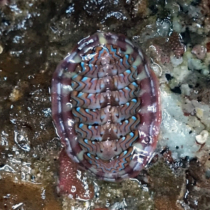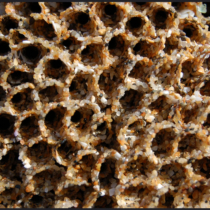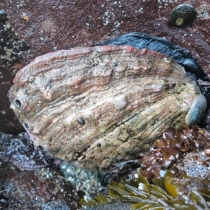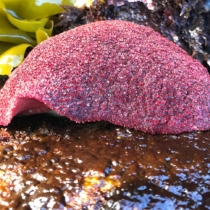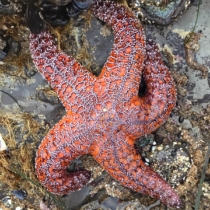Our main objective for monitoring the sandy beach is to establish baseline information about the abundance and distribution of the Pacific mole crab. By monitoring, we can track changes (or lack of changes) in abundance over time. The sampling methods are described below.
Setting Up the Sample Area:
Sand crabs are surveyed along a 50-m segment of each beach. The beach is divided into two areas, one for conducting a systematic search of where the sand crab habitat begins and one for collecting the samples slightly down the beach from the search area. Sand crab abundance is estimated by sampling three to eight randomly placed vertical transects within a 50-m stretch of each beach with evidence of sand crabs. For larger beaches, such as Ocean Beach, the number of 50-m stretches of beach varies depending on the size of the beach. Vertical transects extend between the high tide strand line and the lower end of the swash zone (ankle deep water 10 – 20cm). A series of observations are made to determine where to start the vertical transect so that it is just above the wet sand indicative of suitable sand crab habitat. Restricting sampling to the swash zone is important when interested in estimating sand crab availability to surfperch (Nielsen et al. 2017).
Teams systematically search for the top of the sand crab zone by making the following observations:
- Beach hoppers indicate the sand is too dry for sand crabs to survive.
- Presence of sand crab carapace molts, “V” shapes in the wet sand from crab antenna, and holes for burrows in swash zone are all indicators of good sand crab habitat and the presence of crabs.
- Foraging shore birds also indicate that there are sand crabs present.
- Sand that is wet enough for sand crabs to survive until once again submerged with the rising tide.
Once the top of the sand crab zone is identified in the sand crab search area, teams measure their vertical transect (VT) length, using a meter tape, from that point into ankle deep water (10cm depth) in the swash zone. Teams record this distance on their data sheets. Teams have the same VT length; however, on the rare occasion when berms are present and the width of the swash zone varies greatly (as can occur seasonally on some beaches) the VT length can be adjusted to follow the swash zone contours. Your LiMPETS Coordinator will tell you if this applies to your monitoring event and what to do. Details on how we deal with these situations are described in our Quality Assurance Project Plan. A 50m transect is laid out shoreward of the identified sand crab zone and parallel to the water line in an undisturbed area adjacent to the searching activity area. Vertical transects are dispersed along the 50m line at randomly selected locations.
Collecting Samples:
Starting at the top of the vertical transect (LiMPETS Coordinators mark this based on the results of the search) students will begin collecting their 10 samples. One student, the corer, will press the core (10 cm diameter) into the sand approximately 10 cm while another student holds the first mesh bag to receive the sand. Then the corer will use their pacing step to move to the next sample point, and take the next core into the second mesh bag. Meanwhile, the other students should be bringing the next mesh bags down to the corer in order, and they should be bringing the full bags up to the dry sand. Once all 10 samples are collected, students can begin sifting through the bags by dunking them into a bucket of water one at a time.
Recording Data:
If mole crabs are present in a sample, determine the size and sex of each crab. Determine the size by measuring the length of the carapace with a caliper (to the nearest millimeter). Determine sex by carefully lifting the telson. Females are identified by the presence of modified legs, or pleopods, under the telson. Ovigerous females are identified by an orange or brown mass of eggs. Males lack both pleopods and eggs. sex cannot be determined if crabs are 9 mm or smaller. These tiny crabs are considered “recruits.” Record data on data sheets and return animals to the swash zone before beginning the next bag.
Parasite Analysis:
In this optional extension to sandy beach monitoring, the presence of a parasitic worm (Phlyum: Acanthocephala) is investigated. A fishing permit or scientific collecting permit is needed to conduct this activity. About 30 crabs should be collected and placed in a zip lock bag. Place the ziplock bag in a freezer for more than 4 hours. Thaw and dissect crabs. Count the number of parasites present in the midgut of each crab.
A description of our adaptive sampling methods used from September 2016 – May 2019 can be found here





